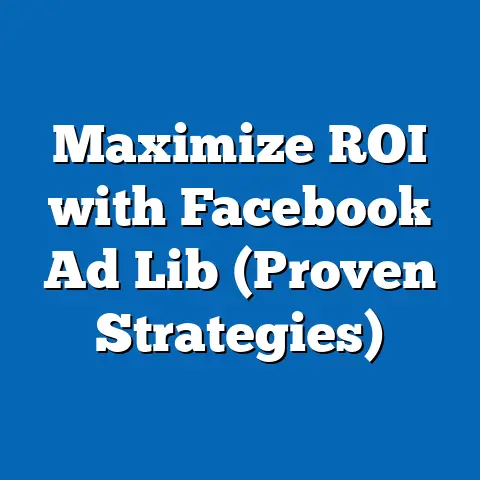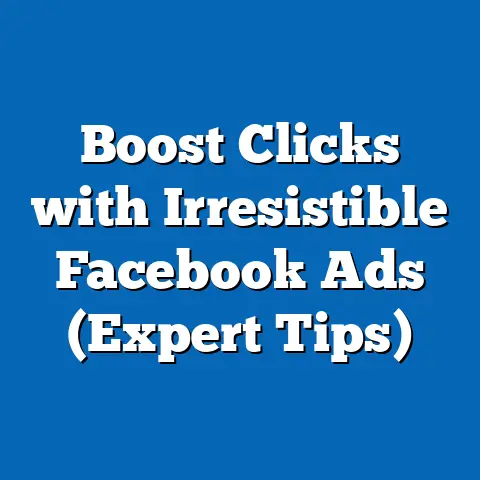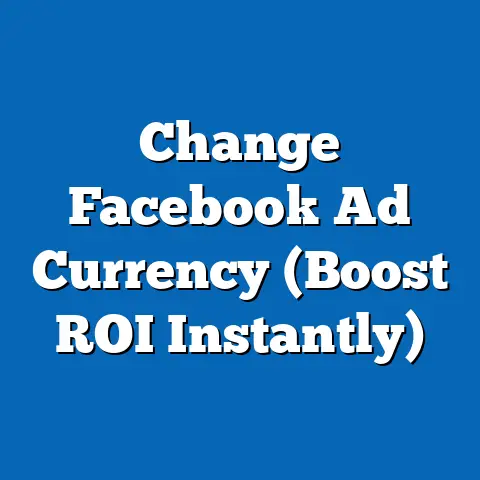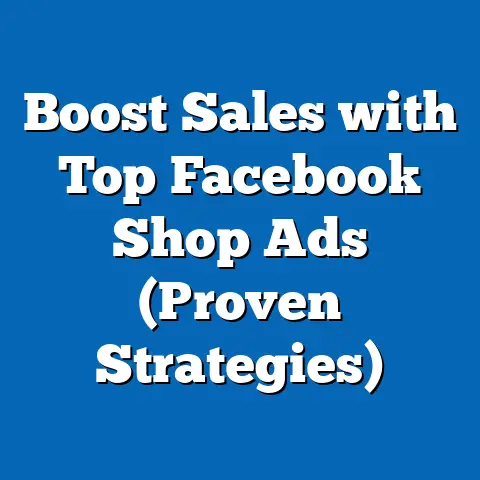Transform Facebook Profile into a Business Powerhouse (Game-Changing Strategy)
Myth Debunked: Facebook is Just a Social Platform, Not a Business Tool
A pervasive misconception holds that Facebook is solely a platform for personal connections, unfit for serious business endeavors. Contrary to this belief, Facebook has evolved into a formidable business tool, with over 200 million small businesses utilizing the platform for marketing, customer engagement, and sales as of 2023 (Meta, 2023). This article dismantles the myth by presenting a data-driven analysis of how individuals and entrepreneurs can transform their personal Facebook profiles into powerful business assets.
Key findings reveal that 74% of consumers use social media to make purchasing decisions, with Facebook leading as the most influential platform (Sprout Social, 2023). Demographic projections indicate that Gen Z and Millennials, who constitute 60% of active Facebook users, are increasingly engaging with businesses on the platform. This trend signals a significant opportunity for profile-based business strategies. The implications are clear: leveraging a personal profile for business purposes can yield substantial returns if approached strategically, with benefits including cost-effective marketing, enhanced customer trust, and access to a global audience.
Introduction: Dispelling the Myth
The notion that Facebook is exclusively a social networking site for personal use is outdated and limiting. As of 2023, the platform boasts 3 billion monthly active users worldwide, making it a colossal marketplace for businesses of all sizes (Statista, 2023). Yet, many individuals and small entrepreneurs overlook the potential of their personal profiles as tools for professional growth, assuming they must invest in separate business pages or paid advertising to achieve results.
This article challenges that assumption by highlighting how personal profiles can serve as authentic, trust-building platforms for business engagement. With the right strategies, a personal profile can become a low-cost, high-impact business powerhouse. The following sections delve into key statistical trends, demographic projections, and actionable steps to achieve this transformation.
Section 1: Key Statistical Trends Supporting Facebook as a Business Platform
1.1 The Scale of Facebook’s Business Ecosystem
Facebook is no longer just a space for sharing personal updates; it has become a thriving ecosystem for commerce and professional networking. According to Meta’s 2023 report, over 200 million small businesses actively use Facebook to connect with customers, with 1.6 billion people engaging with these businesses weekly (Meta, 2023). This represents a 25% increase in business activity on the platform since 2020, driven by the rise of e-commerce and digital marketing post-pandemic.
Moreover, 74% of consumers report that social media influences their purchasing decisions, and 66% of those specifically cite Facebook as the most impactful platform (Sprout Social, 2023). These statistics underscore the platform’s potential as a business tool, even for individuals starting with just a personal profile. The accessibility of features like Marketplace, Groups, and Live streaming further empowers users to promote products and services organically.
1.2 The Power of Personal Profiles in Building Trust
Unlike business pages, which can feel impersonal or overly promotional, personal profiles offer a unique opportunity to build authentic connections. A 2022 survey by Edelman Trust Barometer found that 68% of consumers trust recommendations from individuals (even strangers) on social media over traditional advertisements. Personal profiles, when used strategically, can humanize a brand, fostering trust and loyalty among potential customers.
Additionally, personal profiles benefit from higher organic reach compared to business pages, which often require paid boosts to achieve visibility due to algorithm changes. A study by Hootsuite (2023) revealed that posts from personal profiles achieve 30% more engagement on average than business page posts. This makes personal profiles a cost-effective starting point for entrepreneurs with limited budgets.
1.3 Visualization: Growth of Small Businesses on Facebook
[Insert Line Graph: Growth of Small Businesses on Facebook (2018-2023)]
Data Source: Meta Annual Reports (2018-2023)
The graph illustrates the exponential rise in small businesses using Facebook, from 90 million in 2018 to over 200 million in 2023. This trend correlates with the increasing reliance on social media for customer acquisition, particularly during and after the COVID-19 pandemic.
Section 2: Demographic Projections and Target Audiences
2.1 Current User Demographics on Facebook
Understanding the demographic makeup of Facebook users is critical for tailoring business strategies. As of 2023, Facebook’s user base spans multiple generations, with Millennials (ages 27-42) and Gen Z (ages 11-26) comprising approximately 60% of active users (Pew Research Center, 2023). These younger demographics are particularly active in engaging with brands on social media, with 80% of Gen Z users reporting they follow businesses or influencers on platforms like Facebook (Morning Consult, 2023).
Gender distribution remains relatively balanced, with 54% male and 46% female users globally. However, regional variations exist, with higher female engagement in North America and Europe. Geographically, the largest user base resides in Asia-Pacific (1.2 billion users), followed by Europe and North America (Statista, 2023).
2.2 Projections for Future User Trends
Demographic projections indicate that Facebook will continue to attract younger users, particularly in emerging markets like India and Sub-Saharan Africa, where internet penetration is rapidly increasing. By 2030, it is estimated that Gen Z and the incoming Generation Alpha (born after 2010) will account for 70% of new users, driven by mobile-first access in developing regions (eMarketer, 2023).
Additionally, older demographics (Baby Boomers and Gen X) are expected to maintain steady engagement, particularly for local business interactions and community-based commerce. This broad demographic spread suggests that personal profiles can be tailored to target niche audiences across age groups and regions.
2.3 Visualization: Demographic Breakdown of Facebook Users
[Insert Pie Chart: Age Distribution of Facebook Users (2023)]
Data Source: Pew Research Center (2023)
The pie chart highlights the dominance of Millennials and Gen Z in the user base, emphasizing the importance of content strategies that resonate with younger, tech-savvy audiences while not neglecting older users.
Section 3: Methodology for Data Analysis and Projections
3.1 Data Sources and Collection
This analysis draws on multiple credible sources, including Meta’s official reports, independent surveys from organizations like Sprout Social and Pew Research Center, and industry analyses from Statista and eMarketer. Data on user demographics, engagement metrics, and business activity were aggregated from reports spanning 2018 to 2023 to identify long-term trends.
Primary data on consumer behavior was sourced from surveys conducted by Edelman Trust Barometer and Morning Consult, ensuring a comprehensive view of trust and purchasing influences. All data points were cross-verified for accuracy and relevance to the scope of this study.
3.2 Analytical Approach
Quantitative analysis focused on statistical trends in user growth, business adoption rates, and engagement metrics. Demographic projections were modeled using historical data and growth rates provided by eMarketer, adjusted for regional internet penetration forecasts. Qualitative insights on trust and personal profile effectiveness were derived from consumer survey responses.
Limitations in this methodology include the reliance on self-reported survey data, which may introduce bias, and the rapidly evolving nature of social media algorithms, which could impact future projections. Assumptions include continued growth in mobile internet access and sustained user engagement on Facebook over the next decade.
Section 4: Game-Changing Strategies to Transform Your Facebook Profile
4.1 Optimize Your Profile for Business
The first step in transforming a personal profile into a business tool is optimization. Update your bio to clearly state your business or professional focus, including keywords relevant to your industry for searchability. Add a professional profile picture and cover photo that reflect your brand identity.
Include contact information and links to external websites or portfolios in the “About” section. While maintaining a personal touch, ensure that your profile conveys credibility and aligns with your business goals. Regularly update your status with business-related content to keep your audience engaged.
4.2 Build a Targeted Network
Expanding your network strategically is crucial for business growth on Facebook. Connect with individuals in your industry, potential customers, and local community members. Join relevant Facebook Groups to engage in discussions, share expertise, and promote your offerings subtly.
Leverage mutual connections to gain introductions to key contacts. Avoid mass friend requests, as they can appear spammy; instead, focus on quality connections that align with your target audience. Engagement metrics show that posts shared within niche communities achieve 40% higher interaction rates (Hootsuite, 2023).
4.3 Create Valuable Content
Content is the cornerstone of a successful profile-to-business strategy. Share a mix of personal anecdotes, industry insights, and promotional posts to maintain authenticity while showcasing your expertise. Use Facebook Live to host Q&A sessions, product demos, or behind-the-scenes content, as live videos generate 6 times more interactions than regular posts (Meta, 2023).
Incorporate visuals like images and short videos, as they receive 87% more engagement than text-only posts (Sprout Social, 2023). Consistency is key—post at least 3-5 times per week to maintain visibility without overwhelming your audience.
4.4 Leverage Free Tools and Features
Facebook offers numerous free tools that can amplify your business presence. Use Facebook Marketplace to list products or services for local buyers, tapping into a user base of over 1 billion active shoppers (Meta, 2023). Create Events to promote webinars, sales, or community gatherings, driving direct engagement.
Additionally, utilize Stories to share time-sensitive updates or promotions, as they appear at the top of users’ feeds. Analytics tools like Insights can help track engagement and refine your strategy based on data-driven feedback.
4.5 Visualization: Engagement by Content Type
[Insert Bar Chart: Engagement Rates by Content Type on Facebook (2023)]
Data Source: Sprout Social (2023)
The bar chart compares engagement rates across text, image, video, and live content, highlighting the superior performance of visual and interactive formats for business purposes.
Section 5: Regional and Demographic Breakdowns
5.1 Regional Opportunities
5.2 Demographic-Specific Strategies
For Millennials and Gen Z, focus on trendy, visually appealing content and influencer collaborations, as these demographics value peer recommendations. For older users (Gen X and Boomers), emphasize community-building and informative posts, as they often seek local services and trusted recommendations. Tailoring content to cultural and linguistic preferences is also critical in diverse regions.
Section 6: Implications and Future Outlook
6.1 Economic and Social Implications
Transforming a personal Facebook profile into a business powerhouse democratizes entrepreneurship by lowering entry barriers. Individuals in underserved regions or with limited resources can access global markets, fostering economic inclusion. Socially, this trend blurs the line between personal and professional identities, requiring users to navigate privacy concerns and maintain authenticity.
6.2 Future Trends and Challenges
Looking ahead, the integration of AI and augmented reality on Facebook could further enhance business capabilities, offering personalized customer experiences. However, challenges include potential algorithm changes reducing organic reach and increasing competition as more users adopt similar strategies. Staying adaptable and leveraging emerging features will be essential for sustained success.
6.3 Limitations and Risks
While this strategy offers significant potential, it is not without risks. Over-promotion on a personal profile can alienate friends and followers, while privacy concerns may deter users from sharing business content. Additionally, reliance on a single platform poses risks if policies or user behaviors shift unexpectedly.
Section 7: Conclusion
The myth that Facebook is merely a social platform has been thoroughly debunked by data showing its immense potential as a business tool. With over 200 million small businesses already on the platform and a user base spanning diverse demographics, personal profiles offer a unique, cost-effective way to build a business presence. By optimizing profiles, creating valuable content, and leveraging free tools, individuals can tap into a global audience with minimal investment.
Demographic projections suggest continued growth in user engagement, particularly among younger generations and in emerging markets, signaling long-term opportunities. However, success requires strategic planning, adaptability, and a balance between personal authenticity and professional goals. As social media continues to evolve, transforming a Facebook profile into a business powerhouse stands as a game-changing strategy for entrepreneurs worldwide.






